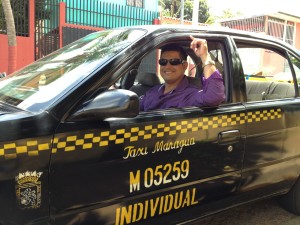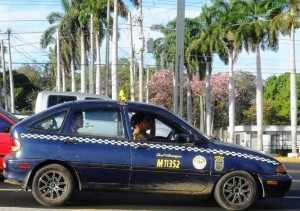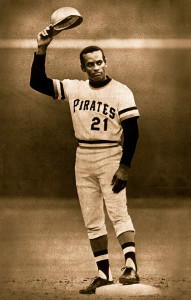
As a young child, I remember falling in love with baseball. Baseball players were my heroes and my friends and I traded baseball cards for our favorites (Oh, to still have those…). In the third grade I signed up for the local little league team but I didn’t have a baseball glove. I remember my mother licking S&H Green Stamps until she had a greeen tongue and enough books filled with stamps to “buy” me a glove. I still have it. I played organized baseball through Little League, Teener League, high school, and Legion Baseball. In those early days, I was a Phillies fan and would strap my transistor radio (check the history books for what that was…) to the handle bars of my bike and ride up on the hill by our house glued to the broadcast of as many games as I could every summer.
In 1964, beloved Phillies had 12 games left in the season with a 6.5 game lead over St. Louis and Cincinnati. Their magic number was 6…any combination of six wins by them or losses by the Cardinals and Reds who were hot on their heels. They should have been a “lock” to win the National League Pennant and move on to the World Series. Instead, the Phillies collapse was epic. They lost 10 games in a row, finished third in the NL and the St. Louis Cardinals went on to win the NL Pennant and the World Series. I haven’t listened to the Phillies since. Go Orioles !!!
But my love of baseball never waned. My son Mark and I took a motorcycle trip with a memorable stop in Cooperstown, NY to visit the Baseball Hall of Fame…sacred, hallowed ground to baseball fans (…we were actually heading to Canada to buy Cuban cigars…!!!). While walking through that quiet, reverent place of commemorating the greats of the game, one couldn’t help but feel the aura honoring the players enshrined there. They are there because of their accomplishments on the field. And no one deserves that honor more than Roberto Clemente. With a .317 life time batting average, 240 career home runs, 2 World Series Championships, 12 All Star appearances, 12 straight Gold Glove awards as a right-fielder along with National League MVP and World Series MVP awards, he is the epitome of a consummate ballplayer both on and off the field. In what would be the last at-bat of his career, Clemente got his 3,000th hit–a double. There is no doubt his achievements on the field are worthy of his enshrinement in the Hall of Fame (92% of the vote on the first ballot). But it is his off-the-field devotion to the community that makes him such a remarkable man and role model for children.
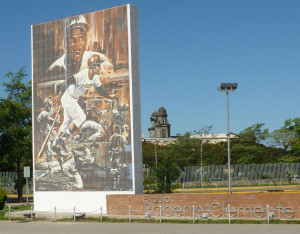 Even though Clemente was from Puerto Rico (not Nicaragua), imagine my surprise when I saw a baseball stadium and marker named after the Pittsburgh Pirates legend in the center of downtown Old Managua. Those of us old enough will remember that Clemente was tragically lost in an airplane accident in 1972 cutting short what would have been the final years of an amazing career but the details of that loss are not as well known.
Even though Clemente was from Puerto Rico (not Nicaragua), imagine my surprise when I saw a baseball stadium and marker named after the Pittsburgh Pirates legend in the center of downtown Old Managua. Those of us old enough will remember that Clemente was tragically lost in an airplane accident in 1972 cutting short what would have been the final years of an amazing career but the details of that loss are not as well known.
In 1972, Nicaragua was hit by a devastating earthquake that killed more than 6,000 people, injured some 20,000 and more than 250,000 people were left homeless. The city was devastated. Clemente did more than simply donate some money to the relief effort. He organized and gathered supplies to help those in need in Nicaragua during an unbelievable time of national disaster and arranged to fly them to Nicaragua. Unbelievably, however, the Somosa government was so corrupt at the time that it was stealing the supplies from the planes at the airport intended to help the Nicaraguan people–three planes had been sent with similar results and the supplies never reached the people in need. In an effort to assure the crucial supplies actually reached the people of Nicaragua whose lives were devastated by the quake, Roberto Clemente thought his presence on the next relief flight to Nicaragua might thwart any efforts by the Somosa government to steal the supplies and bring international attention to what was happening in Nicaragua. It was a fateful decision. Shortly after take off, Clemente’s overloaded plane went down in the ocean and no survivors were ever found.
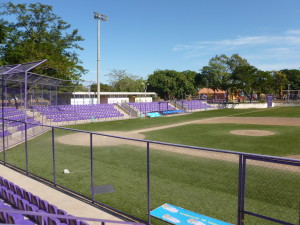 The stadium that honors his memory and his efforts to help the people of Nicaragua is small but beautifully maintained. Although the gates to the playing field were locked when I was there, I tried desparately to get the maintanance man to let me in and take my picture at home plate. He explained, in Spanish, that only the Ministry of Sports had the key to the stadium and he pointed to a building off in the distance that I would have to visit to get permission (and the key) to go on the field. In spite of my desire to commemorate my visit and considering my “command” of the language, I thought such an occurrence highly unlikely and decided to forego the walk to the building.
The stadium that honors his memory and his efforts to help the people of Nicaragua is small but beautifully maintained. Although the gates to the playing field were locked when I was there, I tried desparately to get the maintanance man to let me in and take my picture at home plate. He explained, in Spanish, that only the Ministry of Sports had the key to the stadium and he pointed to a building off in the distance that I would have to visit to get permission (and the key) to go on the field. In spite of my desire to commemorate my visit and considering my “command” of the language, I thought such an occurrence highly unlikely and decided to forego the walk to the building.
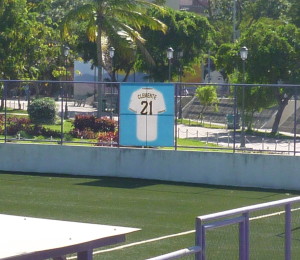
In each section of the outfield, Clemente’s jersey and uniform number is posted (left field, center field, and right field). The grass and grounds are beautifully maintained and the baseball stadium is the centerpiece of a relatively new park built for the people of Managua (Parque Luis Alfonso Velasquez Flores). A family oriented-park with playgrounds, soccer fields, basketball courts, and family gathering areas, it represents just how important Clemente was to this community and, I am sure, the kind of legacy he would have wanted to leave behind. Clemente was a remarkable man and the people of Nicaragua have never forgotten his valiant effort to help them.

